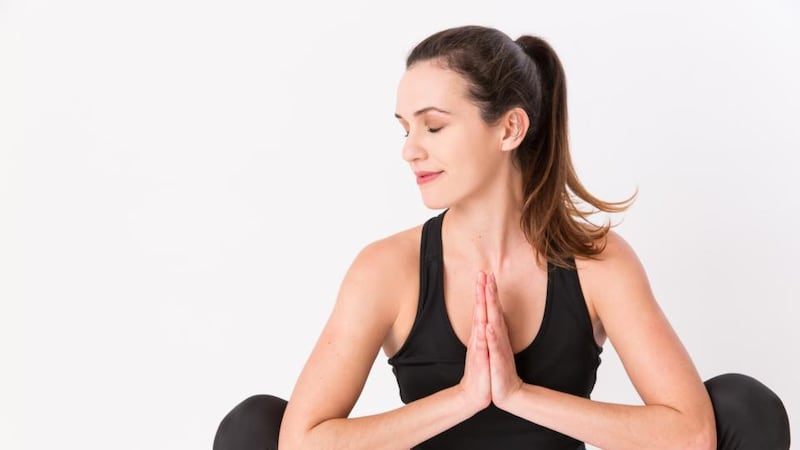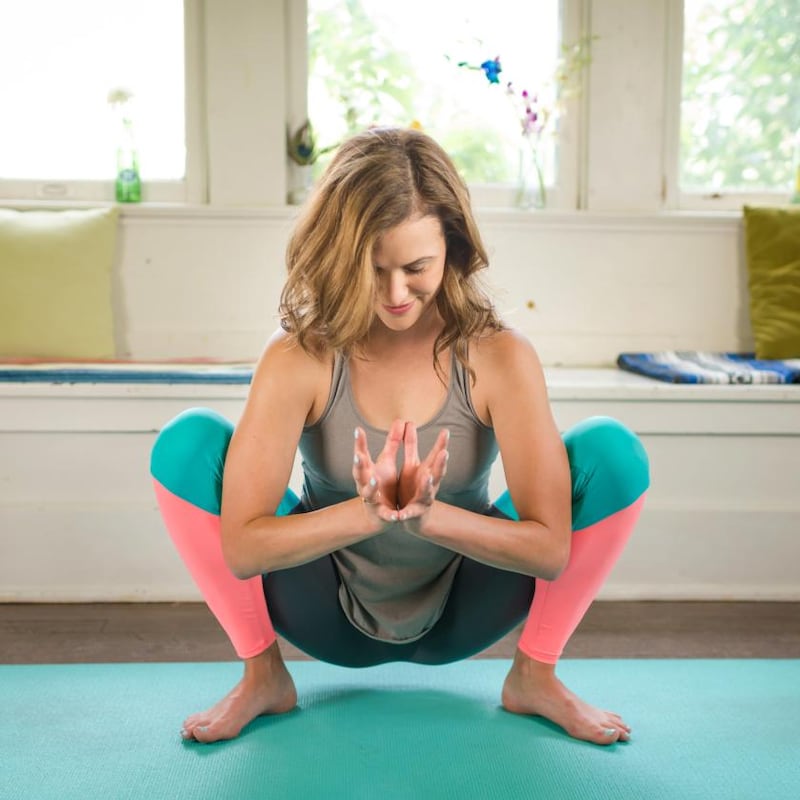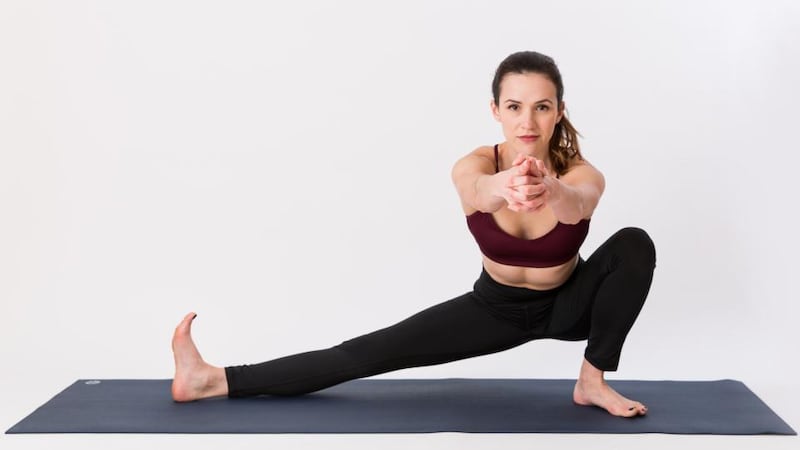There are more than 2,400 people in the main hall of Alexandra Palace, in north London, breathing in unison. “Take the deepest breath you’ve taken all day,” the woman at the front says, “and let it out through the mouth.” Lungs empty en masse. It feels like we’re in the belly of a beast.
The woman is the 33-year-old yogi and actor Adriene Mishler, and this is the largest live yoga class she has ever held – she is more frequently to be found teaching alone in front of her camera at home in Austin, Texas, than IRL. And it is this intimate version of her that four million subscribers to her Yoga with Adriene YouTube channel have come to know and share their homes with.
Her particularly popular videos – "Yoga Morning Fresh", for instance, or "7-Minute Bedtime Yoga" – can get upwards of two million viewers. Search "yoga" on Google, and Mishler dominates.

There is a lot to be said for being gently cajoled into focusing on the feeling of the soles of your feet on the yoga mat, after a day of anxious thoughts
“You just want to be her friend,” says Magdalena Krohn, a 32-year-old teacher and performance artist who is at the Alexandra Palace event, queueing for a cashew curry. Karen Bradley, a 56-year-old health visitor, has travelled from Sheffield, in northern England, to see Mishler. Julie Ashen, a 50-year-old civil servant, says she is “not that brilliant with people” but has nevertheless travelled from Swansea, in Wales, to see Mishler in this setting. You must love her, I say. “I do. She’s quite a phenomenon.”
When I tell friends I am meeting Mishler they get a zealous look in their eyes: “I’m not hyperbolising when I say she changed my life,” more than one confesses – and I know they’re not, because she changed mine, too. Maybe it’s simplistic, but there is a lot to be said for being gently cajoled into focusing on the feeling of the soles of your feet on the yoga mat, when anxious thoughts have been jolting like runaway trains through your mind all day.
We meet the day before the event, over an on-brand turmeric latte in an east London cafe. In real life Mishler is as enthusiastic as her on-screen self – peppy yet sage, welcoming and warm. I mention this special alchemy that has fans talking about her as if she’s a friend. “Yeah, and we are,” she says immediately, as though she feels it too. “Whenever I meet people I’m always, like, ‘Holy shit, it’s such an honour – I get to be in people’s homes, their most vulnerable place.’ ”
Her chat is peppered with talk of blessings and angels, but I would challenge even the most cynical-hearted not to want to get a second round of lattes in. She has a snort-out-loud sense of humour, with a confidence she attributes to a childhood raised by “creative hippies”.
The yoga community can feel intimidating – bodies contorted for aspirational Instagram posts, or studios where you are pushed uncomfortably deep into poses – but Mishler has positioned herself in opposition to the unrealistically ascetic side. “I used to make margarita jokes, just to get people to see that yoga is not only for people who sit in lotus all day and sip yogi tea.” She measures her language carefully: “I don’t want to criticise people doing the pretzel [poses], but I think there’s a lack of awareness.”
“Find what feels good” has been her motto ever since she started, in 2012 – her followers recite it with almost evangelical fervour. This approach is part of what has drawn the numbers to her videos, and crowds to north London despite the £40 (about €45) ticket price – as well as to the other stops on this sold-out European tour, which includes free classes.
For Krohn, “Adriene was the first teacher who really got me to understand that yoga was about more than just physical flexibility or that kind of ego-driven thing that goes with modern yoga.” Bradley came to yoga because she has arthritis – Mishler has, she says, helped her find some acceptance: “This is where you are … You can still do things but don’t push it, find what you can do.”

Practising at home has obvious advantages: people cite cheapness, struggling to get to a studio because of health issues, and fitting quick sessions in around family life. Mishler's focus is on accessibility: yoga for all. You could question the altruism – as with any personality on YouTube, she earns revenue from her well-watched channel. (The analytics firm Social Blade puts the brand's annual earnings at more than €300,000.) She has a sponsorship deal with Adidas, and subscribers willing to pay $9.99 (€8.50) a month to access extra content on her Find What Feels Good site. But with millions of people able to access her yoga for free, I'll get to critiques of her motivation once I've untangled from pigeon pose.
Yoga is a booming industry – last year the market was worth almost €70 billion globally. Once a trailblazer, Mishler is now one of a host of online yoga teachers bringing an ancient practice to a mass, modern audience. “There are a lot of people who think it’s a little bit questionable,” she concedes. “I get why people from India are going, ‘Hey, what the hell are you doing?’ ”
Cultural appropriation is a criticism she has seen levelled at a lot of American teachers and one that she thinks, to an extent, is fair. Has she ever been criticised herself? “I don’t actually get it that much, and, the only times I do, I can tell that person’s never done any of my videos. They’re lumping me in because I’m white, wearing Adidas pants.” She has, she says, “tried to teach the real, traditional-style yoga … I really want to honour the philosophy.”
But that doesn't mean there hasn't been room for some online savvy. Her business partner, Chris Sharpe, whom she met on the set of a horror film and who had previously produced the successful YouTube series Hilah Cooking, was aware of the need to push the videos up the search-engine rankings. It made for knotty decisions. "I did not want to call anything 'yoga for weight loss' in the beginning," she says. But they struck a deal and tried it. "It did so disgustingly well."

They started to play around and chose words they knew would rank highly. She cites a video called Six Pack Abs. “Is that what we abide by, and are six-pack abs really possible for women? Nooooo. Anatomically, it’s just ridiculous. But I’m kind of making fun of it.” In the video she begins in the persona of a dumbbell bunny, before quickly caving: “Just kidding. If you know me at all I don’t really subscribe to that obsession.” If you’re not familiar with her shtick you could be forgiven for thinking it a cynical move to get the ratings up. But she is no stranger to body-image issues herself, mentioning that, before auditions, she has felt a pressure to diet.
Even now, she says, being “on YouTube, in tight clothing”, means she has had to work hard to avoid feeling the same pressures. Instead, she says, she wants to “get people closer to experiencing pure love and acceptance for themselves”. She sees these video titles, antithetical to her message, as Trojan horses, bringing people to her channel so she can deliver her alternative: “You can look good all you want, but if you’re still looking in the mirror and not loving who you see, we have it backwards.” It might sound schmaltzy written down, but it is clearly a much-needed message.
So why yoga, and why now? It is irresistible to link turbulent times with a practice that can help you feel grounded. I try to make it that neat: has she seen an uptick in numbers on her channels since Trump took office, say? “I don’t know how the numbers have changed in terms of big shifts in politics,” she says, “but I do know that as a woman and as a human living in this time, I feel it.”
And she clearly wants her yoga to cut through. She weighs up the next words, almost egging herself on. “I want all the people who voted for Trump to do my yoga. I want all the people who battle with the experience of racism to do yoga.” There’s that yoga-for-all message again.
We're insinuating the only way to feel good is if you can afford to buy this $65 detox tea, and then it comes in the mail and you're, like, 'What the f***? I could make this'
Her mother is Mexican, and in recent years Mishler has been embracing her heritage more. "Not that I've ever tried to hide it – hell no," she says. "But I wasn't raised bilingual, and I happen to be fair-skinned. Then I had a moment a couple of years ago when I was, like, 'Shoooot, I'm Mexican and nobody knows it.' " She is learning Spanish. "My goal is to be able to do a playlist on my channel that's all yoga español."
Her brand’s meteoric rise has undoubtedly been helped by the boom in the global wellness industry – estimated in 2015 to be worth nearly €3.5 trillion – and Mishler knows it. “I’d be lying if I didn’t say Chris anticipated this … He had the idea of creating something in the world of wellness for a reason.”
As for the recent politicisation of the wellness industry, especially in reaction to the more elitist side of it, “I just think that it’s like everything. It’s really not about what you’re putting out there; it’s about how you’re doing it. We’re saying we want everyone to feel good, and yet we’re insinuating the only way to do that is if you have enough money to buy this $65 detox tea, and then it comes in the mail and you’re, like, ‘What the f***? I could make this.’ ”
It's not something she's immune to, either. "Hell yeah, I've Gooped," Which is why, she says, she has started to care about the numbers. "It gives me more power to be, like, the people's yogi."
Back in the hall at Alexandra Palace we’re finishing the evening’s practice by hugging ourselves – yes, you read right. Mishler cracks a joke, and then we’re all breathing in unison again, like one big, collective lung. – Guardian



















